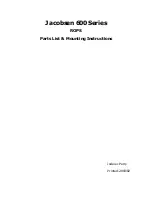
Subject to change without notice
21
experience is most frequently needed.
Testing Diodes
Diodes normally show at least their knee in the forward
characteristic. This is not valid for some high voltage diode
types, because they contain a series connection of several
diodes. Possibly only a small portion of the knee is visible.
Z-diodes always show their forward knee and, up to
approx. 7V, their Z-breakdown, forms a second knee in the
opposite direction. A Z-breakdown voltage of more than
6.8V can not be displayed.
The polarity of an unknown diode can be identified by
comparison with a known diode.
Testing Transistors
Three different tests can be made to transistors: base-
emitter, base-collector and emitter-collector. The resulting
test patterns are shown below.
The basic equivalent circuit of a transistor is a Z-diode
between base and emitter and a normal diode with
reverse polarity between base and collector in series
connection. There are three different test patterns:
For a transistor the figures b-e and b-c are important. The
figure e-c can vary; but a vertcal line only shows short
circuit condition.
These transistor test patterns are valid in most cases,
but there are exceptions to the rule (e.g. Darlington,
FETs). With the
COMP. TESTER
, the distinction
between a P-N-P to an N-P-N transistor is discenible. In
case of doubt, comparison with a known type is helpful.
It should be noted that the same socket connection
(
COMP. TESTER
or ground) for the same terminal is
then absolutely necessary. A connection inversion
effects a rotation of the test pattern by 180 degrees
round about the center point of the scope graticule.
In-Circuit Tests
Caution! During in-circuit tests make sure the circuit
is dead. No power from mains/line or battery and no
signal inputs are permitted. Remove all ground
connections including Safety Earth (pull out power
plug from outlet). Remove all measuring cables
including probes between oscilloscope and circuit
under test. Otherwise both COMP. TESTER leads are
not isolated against the circuit under test.
In-circuit tests are possible in many cases. However, they
are not well defined. This is caused by a shunt connection
of real or complex impedances
−
especially if they are of
relatively low impedance at 50Hz
−
to the component
under test, often results differ greatly when compared
with single components. In case of doubt, one component
terminal may be unsoldered. This terminal should then be
connected to the insulated
COMP. TESTER
socket
avoiding hum distortion of the test pattern.
Another way is a test pattern comparison to an identical
circuit which is known to be operational (likewise without
power and any external connections). Using the test
prods, identical test points in each circuit can be checked,
and a defect can be determined quickly and easily. Possibly
the device itself under test contains a reference circuit
(e.g. a second stereo channel, push-pull amplifier,
symmetrical bridge circuit), which is not defective.
The test patterns on page 22 show some typical displays
for in-circuit tests.
Type:
Normal Diode
High Voltage Diode
Z-Diode 6.8V
Terminals:
Cathode-Anode
Cathode-Anode
Cathode-Anode
Connections:
(CT-GD)
(CT-GD)
(CT-GD)
P-N-P Transistor
N-P-N Transistor
Terminals:
b-e
b-c
e-c
Connections:
(CT-GD)
(CT-GD)
(CT-GD)
Terminals:
b-e
b-c
e-c
Connections:
(CT-GD)
(CT-GD)
(CT-GD)











































